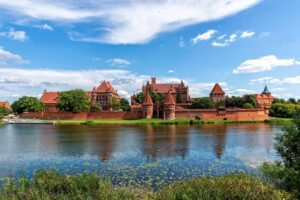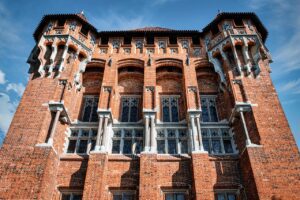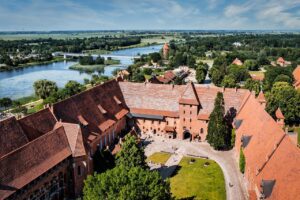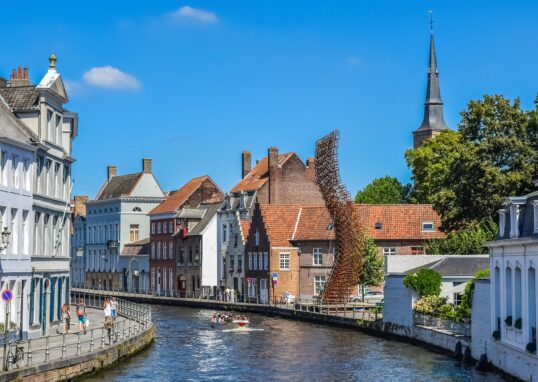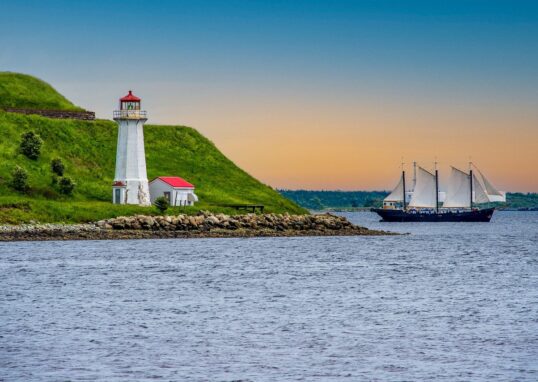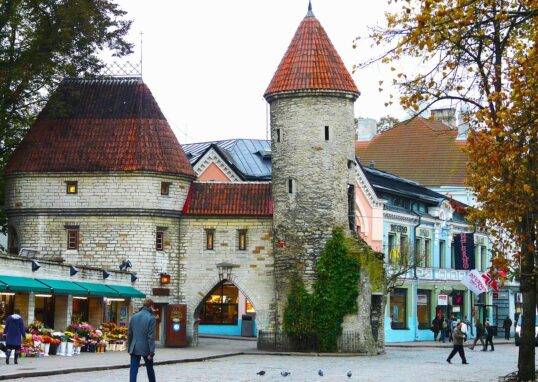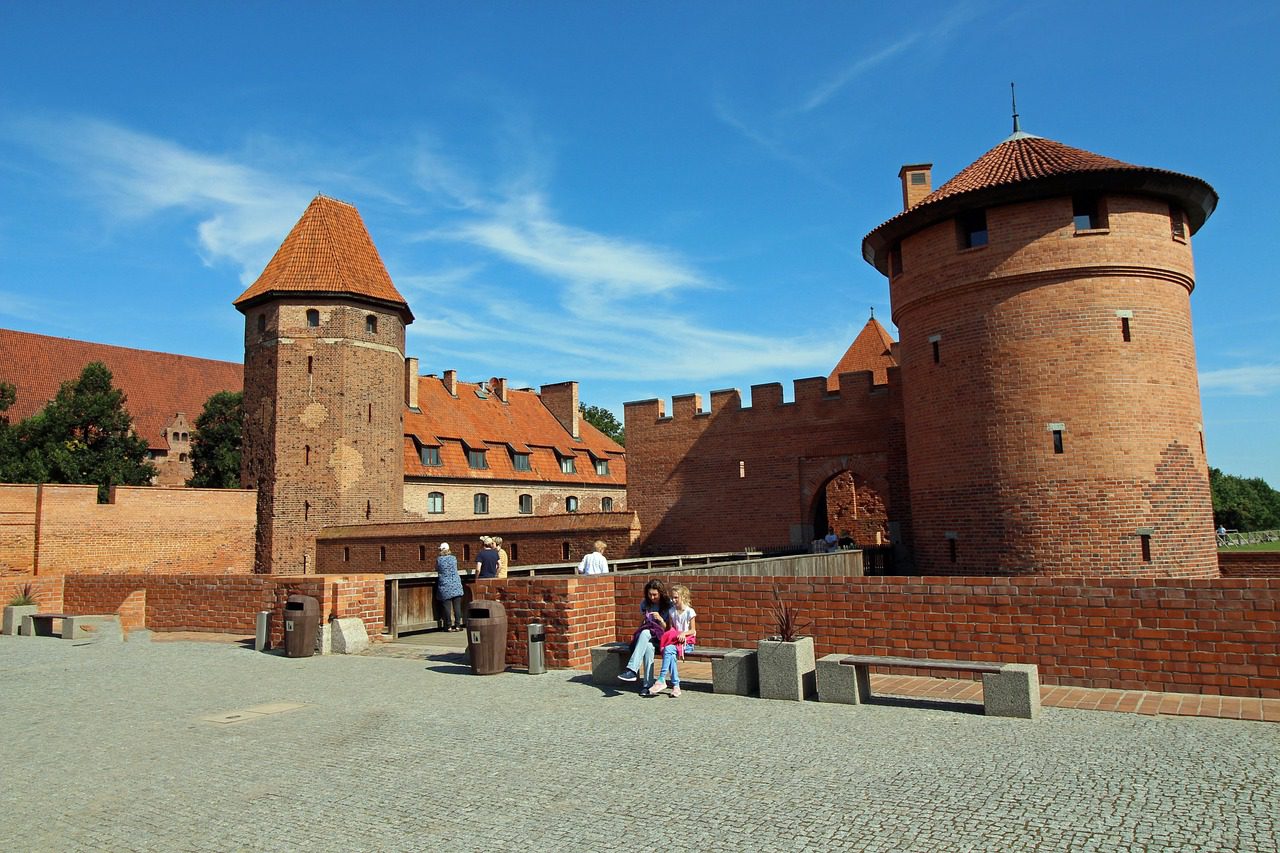
Castle of the Teutonic Order in Malbork, Poland – A Timeless Medieval Wonder
The Teutonic Order’s Malbork Castle is one of the world’s most impressive medieval castles. It is located in Malbork, a small town in north Poland, on the River Nogat. The castle was built in the 13th century by the Teutonic Knights and is not only massive but also one of the best instances of Gothic brick architecture. It was made a UNESCO World Heritage Site in 1997 because of its historical and architectural importance. Traveling to the site is equivalent to traveling back in time to the Middle Ages when knights ruled the land, wars decided kingdoms, and stone walls murmured stories of religion, war, and power.
Historical Background
The history of the Malbork Castle begins in 1274 when the Teutonic Order, a Christian order of knights, began its construction. The order had originally come from Germany, and its mission was to spread Christianity and defend the faith on heathen ground. The order had settled in the region of the Baltic and chose Malbork (then Marienburg) as its new seat. It was called “Marienburg” in honor of the Virgin Mary, the patron saint of the Teutonic Order.
Architecture and Design
A Masterpiece of Brick Gothic Style
Malbork Castle is a prime example of Brick Gothic architecture, a style common in Northern Europe, especially where natural stone was scarce. Every wall, tower, and corridor is built using millions of red bricks, neatly arranged to create solid walls and intricate patterns. The castle is divided into three main components:
- The High Castle (Upper Castle), The Middle Castle, The Lower Castle (Outer Bailey). Each section was built for a specific purpose and had diverse functions during the Teutonic era.
The High Castle
The High Castle is the oldest part and was the monastic center of the Teutonic Order. It includes the church, the chapter house, and the monks’ residences. The Church of the Virgin Mary in the High Castle is one of the most important religious structures in medieval Poland. A statue of the Virgin Mary with Child once stood on the church façade, shining over the land. It was covered in golden mosaic tiles that shone with sunlight for miles — a representation of divine power.
The Middle Castle
The Middle Castle was added later, in the early 14th century, when the Teutonic Knights needed more administrative and living space. It contained the Grand Master’s Palace, the infirmary, the kitchens, and quarters for visiting knights and guests. The most scenic section of the castle is the Palace of the Grand Master. Its large halls, grand fireplaces, and lavish decorations testify to the luxury of medieval nobility. The summer and winter refectories show how comfortably the Teutonic Order adapted to the change of seasons. Its walls were decorated with order symbols, coats of arms, and paintings showing their victories and religious beliefs. Its floors were laid with multicolored tiles, and its windows were designed to let in the perfect amount of light.
The Lower Castle
The Lower Castle was the workplace, where daily functions were carried out. It contained the armories, stables, workshops, and warehouses. It held provisions such as grain, arms, and building materials. The gate towers were also part of the Lower Castle, protecting the fortress from invaders. The moat bridge was raised in times of siege, and it became nearly impossible for invaders to enter.
Strategic Importance
The Malbork Castle was a stronghold, not a home for knights. Located on the Nogat River, it dominated river trade routes, and the Teutonic Order could levy taxes on the merchandise and gain more wealth. Its walls were extremely thick, and the castle possessed multiple layers of defense — a moat, drawbridges, and tall towers for archers. During wars, it could hold thousands of soldiers and food for months. The Teutonic Knights ruled this territory with strict discipline. Their power extended across the Baltic region, and Malbork became the capital of their empire.
Decline and Later History
However, the order’s power did not last forever. In 1410, the Teutonic Knights were defeated by Polish and Lithuanian forces in the Battle of Grunwald. It was one of the largest battles in medieval Europe. After this defeat, the order’s power declined, and the Kingdom of Poland began to gain strength. In 1457, during the Thirteen Years’ War, the castle was finally captured by the Polish King Casimir IV Jagiellon. It then became one of the royal residences of Poland. Malbork was an important military and administrative center for centuries. However, in the 18th and 19th centuries, it deteriorated and was damaged by wars. During World War II, the castle was badly damaged during battles between German and Soviet forces. After the war, Polish conservators rebuilt the castle, brick by brick. Today, the castle is returned to its original form and serves as a museum and cultural center.
The Malbork Castle Museum
The Malbork Castle Museum (Muzeum Zamkowe w Malborku) is among Poland’s most visited heritage sites today. It protects the history, art, and traditions of the Teutonic Order and medieval Europe. Visitors can walk through some dozen chambers filled with artifacts, armor, weaponry, coins, documents, and medieval tools. There are also displays of Gothic art, stained glass, and reconstructed knights’ halls. One of the most memorable collections is the Amber Exhibition, with its ancient amber jewelry and sculptures. Amber has been called “the gold of the Baltic” for centuries, and it was one of the most significant trade goods in the region. The museum also sponsors medieval festivals, reenactments, and evening tours. Summer evenings see the castle filled with torches, music, and dramatic storytelling — bringing the past back to life.
Visitor Experience
A stroll through Malbork Castle is a beholder’s entry into another world. The walls are tall, the halls gently reverberate, and the air is with the aroma of old bricks. The towers give a stunning view of the Nogat River and the Polish countryside. Tourists can walk across the drawbridge, through the courtyards, and up the towers for a panoramic view. There are guided tours in several languages and modern exhibitions using sound and light to restore medieval life. There are cafes and souvenir stores in the complex where traditional Polish cuisine and knight-themed mementos are sold. It’s where history, culture, and fantasy come together effortlessly.
Surrounding Places and Attractions
Malbork Town
Malbork town itself is also worth visiting after viewing the castle. The main square, Plac Slowiański, contains some nice cafes, souvenir shops, and a nice, friendly atmosphere. The Nogat River Promenade is perfect for evening walks with fine views of the castle reflected in the water. You can also boat along the Nogat River to view the fortress from a different perspective. Summer brings festivals and markets, filling the streets with music and local specialties. The nearby Malbork Miniature Park displays small models of Poland’s well-known sights and is a fun stop for families.
Elbląg
About 50 kilometers north of Malbork is the city of Elbląg, which is one of the oldest Polish cities. It has a charming Old Town with painted buildings and cobblestone streets. The Elbląg Canal is a famous feat of engineering — it allows boats to travel uphill by way of special ramps instead of locks. The Archaeological Museum in Elbląg features displays of prehistoric settlements, and the St. Nicholas Cathedral offers good views from its tower.
Gdańsk
About 60 kilometers away is Gdańsk, one of the most beautiful cities on the Baltic Sea. With a rich maritime past, Gdańsk features long market streets, Gothic churches, and elegant Hanseatic architecture. Gdańsk Old Town is full of attractions such as:
- St. Mary’s Church – one of the world’s largest brick churches
- Neptune Fountain – symbol of the city’s maritime connection
- Gdańsk Crane – old port crane for lifting cargo
Gdańsk is also famously associated with amber jewelry and seafood restaurants. The urban beaches and the proximity of sea resorts like Sopot make it a perfect mix of culture and recreation.
Kwidzyn Castle
Approximately 35 kilometers south of Malbork lies Kwidzyn Castle, yet another Gothic castle that was formerly inhabited by the Teutonic Order. Though smaller than Malbork, it is no less fascinating, with a unique bridge tower connecting the castle and the town, an excellent piece of medieval engineering.The Diocese Museum within contains religious art, manuscripts, and archaeological finds. Kwidzyn also provides scenic river views and peaceful parks for a day trip.
Tczew
The town of Tczew, located on the Vistula River, is about 40 kilometers away from Malbork. It’s renowned for its historic bridges and Vistula River Museum, which outlines Poland’s maritime history. Tczew also offers serene walking paths, scenic riverbanks, and viewpoints ideal for photo opportunities.
Sztum Castle
The Sztum Castle is among the most scenic medieval castles in northern Poland. It is located just 15 kilometers from Malbork, in the peaceful town of Sztum. The castle was built in the 14th century by the Teutonic Knights as a fortified residence and administrative compound. It was surrounded by water, forming a picturesque castle island connected by a wooden bridge. The lake near the fortress added to its defense power and formed a great visual impression. Sztum Castle was originally the summer residence of the Grand Masters of the Teutonic Knights, providing a serene and idyllic retreat from the formal and busy life in Malbork. Visitors today can walk around the castle grounds, see small exhibitions, and enjoy scenic views of Lake Sztumskie, which reflects the castle perfectly, especially at sunset. Medieval fairs, knight tournaments, and cultural events that recreate the Middle Ages are also held there. Local vendors sell traditional goods, and actors bring the past to life in costume performances and sword fights. The surrounding town of Sztum finishes the experience with peaceful parks, charming cafés, and lake-side walkways. Together, they form a leisurely retreat filled with history, nature, and timeless beauty.
Gniew Castle
A short distance from Sztum is another breathtaking fortress — the Gniew Castle (Zamek w Gniewie). It looms over the Vistula River, some 60 kilometers north of Malbork, and is one of Poland’s most well-preserved Gothic castles. Built by the Teutonic Knights at the end of the 13th century, it was as much a demonstration of their local hegemony as a fortress. Gniew Castle witnessed many historical ups and downs over the centuries. It was once occupied by Polish King Casimir IV, served as a royal residence, and was even utilized as a prison in the 19th century. What truly distinguishes Gniew Castle, though, is that it’s not a dull, dusty relic. It’s a regular venue for historical reenactments, jousting tournaments, archery contests, and torchlit nighttime tours, which bring the medieval world back to life with great gusto. The Knights’ Hall and royal chambers are elegantly furnished, and the castle courtyard is converted into a theater and music stage during festivals. The surrounding town of Gniew comes with cobblestone streets, old churches, and river views, offering guests a blend of history and tranquility. Whether strolling the castle’s secretive corridors or enjoying a leisurely sunset over the river, Gniew Castle provides an unforgettable visit to the heart of Poland’s medieval history — a perfect adjunct to the forbidding Malbork fortress.
Pelplin Cathedral
Close to Tczew, in the town of Pelplin, there is one of the most stunning Gothic cathedrals in Poland — the Basilica Cathedral of the Assumption of the Blessed Virgin Mary. It’s famous for its high arches, stained glass windows, and elaborate ornamentation. The Diocesan Museum in Pelplin contains a rare copy of the Gutenberg Bible, one of the first books printed in the world.
Bory Tucholskie National Park
Nature lovers have to go to Bory Tucholskie National Park, some 100 kilometers from Malbork. The national park is a vast wooded area complete with lakes, pine woods, and hiking trails. It is home to deer, foxes, and more than hundreds of species of birds.
Baltic Sea Coast
Finally, the Baltic Sea Coast is a short way from Malbork. Some of the towns that possess good beaches, sea breezes, and lively boardwalks are Sopot, Gdynia, and Hel Peninsula. These resorts are packed with locals and tourists in the summer for swimming, sailing, and dining on seafood.
Conclusion
Malbork Castle of the Teutonic Order is more than a historical monument — it’s a symbol of medieval power, human ingenuity, and cultural synthesis. Its massive brick walls, sacred halls, and symmetrical design tell stories of ambition, religion, and endurance. It is one of Poland’s most valuable monuments and one of Europe’s most excellent castles today. Visitors can walk where knights prayed and fought, uncover centuries of history, and look out over breathtaking views of the Nogat River. Among charming towns, ancient cathedrals, and scenic vistas, Malbork offers a clean experience — one that orchestrates the past and present so seamlessly. For the historian, visitor, or dreamer, Malbork Castle promises a worthwhile journey back in time to the medieval core of Europe.

